2020届高三英语上学期阶段性检测 试题
湖北省黄冈市2020届高三英语上学期阶段性检测试题
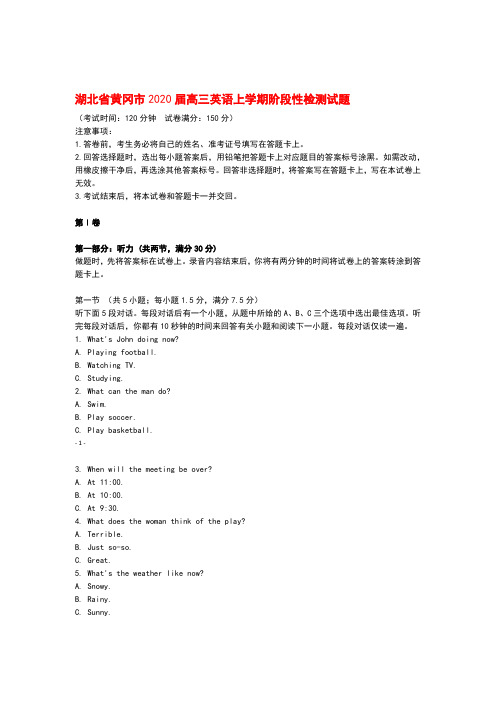
湖北省黄冈市2020届高三英语上学期阶段性检测试题(考试时间:120分钟试卷满分:150分)注意事项:1.答卷前,考生务必将自己的姓名、准考证号填写在答题卡上。
2.回答选择题时,选出每小题答案后,用铅笔把答题卡上对应题目的答案标号涂黑。
如需改动,用橡皮擦干净后,再选涂其他答案标号。
回答非选择题时,将答案写在答题卡上,写在本试卷上无效。
3.考试结束后,将本试卷和答题卡一并交回。
第Ⅰ卷第一部分:听力 (共两节,满分30分)做题时,先将答案标在试卷上。
录音内容结束后,你将有两分钟的时间将试卷上的答案转涂到答题卡上。
第一节(共5小题;每小题1.5分,满分7.5分)听下面5段对话。
每段对话后有一个小题,从题中所给的A、B、C三个选项中选出最佳选项。
听完每段对话后,你都有10秒钟的时间来回答有关小题和阅读下一小题。
每段对话仅读一遍。
1. What's John doing now?A. Playing football.B. Watching TV.C. Studying.2. What can the man do?A. Swim.B. Play soccer.C. Play basketball.- 1 -3. When will the meeting be over?A. At 11:00.B. At 10:00.C. At 9:30.4. What does the woman think of the play?A. Terrible.B. Just so-so.C. Great.5. What's the weather like now?A. Snowy.B. Rainy.C. Sunny.第二节(共15小题,每小题1.5分,满分22.5分)听下面5段对话或独白。
每段对话或独白后有几个小题,从题中所给的A、B、C三个选项中选出最佳选项。
听每段对话或独白前,你将有时间阅读各个小题,每小题5秒钟;听完后,各小题将给出5秒钟的作答时间。
2020届高三英语上学期段考(第二次月考)试题
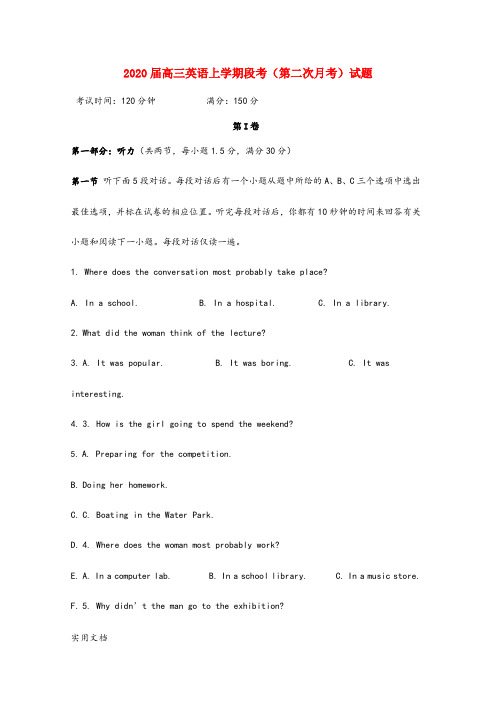
2020届高三英语上学期段考(第二次月考)试题考试时间:120分钟满分:150分第I卷第一部分:听力(共两节,每小题1.5分,满分30分)第一节听下面5段对话。
每段对话后有一个小题从题中所给的A、B、C三个选项中选出最佳选项,并标在试卷的相应位置。
听完每段对话后,你都有10秒钟的时间来回答有关小题和阅读下一小题。
每段对话仅读一遍。
1. Where does the conversation most probably take place?A. In a school.B. In a hospital.C. In a library.2.What did the woman think of the lecture?3.A. It was popular. B. It was boring. C. It wasinteresting.4.3. How is the girl going to spend the weekend?5.A. Preparing for the competition.B.Doing her homework.C.C. Boating in the Water Park.D.4. Where does the woman most probably work?E.A. In a computer lab. B. In a school library. C. In a music store.F.5. Why didn’t the man go to the exhibition?G.A. The ticket was too expensive.H.B. Buying tickets took time.I.C. Da Vinci was not his favorite.J.第二节听下面5段对话或独白。
每段对话或独白后有几个小题,从题中所给的A、B、C三个选项中选出最佳选项,并标在试卷的相应位置。
2020届湖北省黄冈市高三上学期阶段性检测英语试卷

2020届湖北省黄冈市高三上学期阶段性检测英语(考试时间:120分钟试卷满分:150分)注意事项:1.答卷前,考生务必将自己的姓名、准考证号填写在答题卡上。
2.回答选择题时,选出每小题答案后,用铅笔把答题卡上对应题目的答案标号涂黑。
如需改动,用橡皮擦干净后,再选涂其他答案标号。
回答非选择题时,将答案写在答题卡上,写在本试卷上无效。
3.考试结束后,将本试卷和答题卡一并交回。
第Ⅰ卷第一部分:听力(共两节,满分30分)做题时,先将答案标在试卷上。
录音内容结束后,你将有两分钟的时间将试卷上的答案转涂到答题卡上。
第一节(共5小题;每小题1.5分,满分7.5分)听下面5段对话。
每段对话后有一个小题,从题中所给的A、B、C三个选项中选出最佳选项。
听完每段对话后,你都有10秒钟的时间来回答有关小题和阅读下一小题。
每段对话仅读一遍。
1. What’s John doing now?A. Playing football.B. Watching TV.C. Studying.2. What can the man do?A. Swim.B. Play soccer.C. Play basketball.3. When will the meeting be over?A. At 11:00.B. At 10:00.C. At 9:30.4. What does the woman think of the play?A. Terrible.B. Just so-so.C. Great.5. What’s the weather like now?A. Snowy.B. Rainy.C. Sunny.第二节(共15小题,每小题1.5分,满分22.5分)听下面5段对话或独白。
每段对话或独白后有几个小题,从题中所给的A、B、C三个选项中选出最佳选项。
听每段对话或独白前,你将有时间阅读各个小题,每小题5秒钟;听完后,各小题将给出5秒钟的作答时间。
2020届高三英语上学期调研考试试题
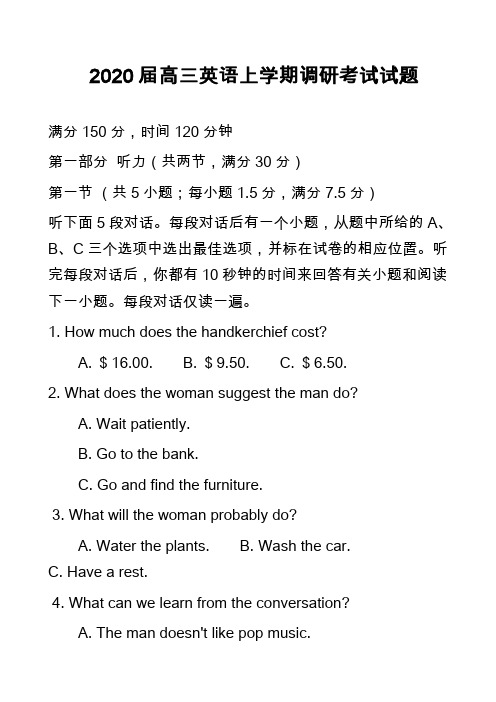
2020届高三英语上学期调研考试试题满分150分,时间120分钟第一部分听力(共两节,满分30分)第一节(共5小题;每小题1.5分,满分7.5分)听下面5段对话。
每段对话后有一个小题,从题中所给的A、B、C三个选项中选出最佳选项,并标在试卷的相应位置。
听完每段对话后,你都有10秒钟的时间来回答有关小题和阅读下一小题。
每段对话仅读一遍。
1. How much does the handkerchief cost?A. $16.00.B. $9.50.C. $6.50.2. What does the woman suggest the man do?A. Wait patiently.B. Go to the bank.C. Go and find the furniture.3. What will the woman probably do?A. Water the plants.B. Wash the car.C. Have a rest.4. What can we learn from the conversation?A. The man doesn't like pop music.B. The woman doesn't like pop music.C. The woman is quite young.5. What do we know about the woman?A. She is not sure how to use the mobile phone.B. She finds it pretty easy to use the mobile phone.C. She often leaves her mobile phone at home.第二节 (共15小题;每小题1.5分,满分22.5)听下面5段对话或独白。
每段对话或独白后有几个小题,从题中所给的A、B、C三个选项中选出最佳选项,并标在试卷的相应位置。
甘肃省2020届高三英语上学期阶段性考试试题.doc

甘肃省2020届高三英语上学期阶段性考试试题考试时间120分钟,总分120第一部分:阅读理解 (共两节,40分)第一节(共15小题;每小题2分,共30分)阅读下列短文,从每题所给的A、B、C、D四个选项中,选出最佳选项,并在答题卡上将该项涂黑。
AOur Annual Cultural EventsA Night in RioWe are proud to bring the energy and enthusiasm of Brazilian Carnival to Charlotte with A Night in Rio! Get a taste of Carnival through dancing, live music, authentic food, drinks and marketplace. Put on your green and yellow, and join us for the unforgettable experience of Brazilian Carnival!Date: Saturday, February 24, 2018TICKETS AVAILABLE ONLY AT THE DOORLocation: Neighborhood Theatre, CharlotteTime: 7 PMRitmo & SaborWe are thrilled to bring the annual celebration Ritmo & Sabor Festival! Featuring dance performances and FREE dance lessons and delicious, authentic Latin cuisine, this festival will be a fantastic celebration for the entire family to enjoy! Food and beer will be available for purchase. Come out to enjoy a great summer evening of Ritmo & Sabor!Date: Saturday July 2, 2018Location: International & Cultural Center, CharlotteTime: 5-11 PMFREE ADMISSIONLas AméricasJoin us in the annual celebration LAS AMÉRICAS! We display our history and identity of Latin America through musical performances, story-telling and poetry. Enjoy yourself with local artists, shop your way through a market of arts and crafts and join in some of the finest Latin American cuisine.Date: August 18, 2018Location: Midwood International & Culture Center, CharlotteTime: 2-7 PMAdmission is FREE.Latin American FestivalFestival Latinoamericano returns for its 28th year, with musical artists and dance performances, a diverse authentic selection of Latin American food, visual artists, and a street festival environment with activities for the whole family.Location: Symphony Park at South Park Mall, CharlotteDate: Saturday Sept. 29 (1-8pm)Admission: $10; Children aged 8 & under are free.1.What does Ritmo & Sabor mainly provide?A.Music and visual art. B.Food and beer.C.Dance and poetry. D.Dance and food.2.What can you do at Las Américas?A.Buy some local crafts as souvenirs. B.Enjoy typical Latin American beer. C.Dance in green and yellow clothes. D.Watch local dancers’ performances. 3.Which event requires a ticket for a seven-year-old child?A.Las Américas. B.Ritmo & Sabor.C.A Night in Rio. D.Latin American Festival.BProfessional athletes pay a high price for their pursuit of excellence and glory. Training to the limit tears muscles and wears out joints. Gymnasts often need hip replacements when barely into middle age. Few footballers make it to the end of their careers with their knees intact.But many also run a darker risk: doping — the use of banned athleticperformance-enhancing drugs by athletic competitors. The Winter Olympics in Pyeongchang, in South Korea, starts this week in its shadow. Years afterwhistle-blowers first revealed wholesale (大规模的) doping in Russia, the International Olympic Committee (IOC) at last decided to bar it from taking part. But it has allowed many Russians to compete as individuals. And on the eve of the competition the Court of Arbitration for Sport (CAS) said that 28 others should receive a more tolerant penalty from the IOC, further muffling the anti-doping message.Russia’s doping is unusual only in its scale and institutional nature. No country or sport is immune. Studies, and an anonymous survey at the World Athletics Championships in 2011, suggest that a third of athletes preparing for big international competitions take banned substances. Yet just 1-2% fail a test each year. Lance Armstrong, a cyclist who won the Tour de France seven times and later admitted to doping all the while, was tested on 250 occasions. The few times he failed, he avoided punishments by claiming he had taken anti-inflammatories (消炎药) for saddle-sores (骑行引起的肌肉酸痛).Doping is more sophisticated than when some states used steroids (类固醇) to bulk up athletes. New drugs are designed to be undetectable in a blood or urine sample. Many athletes “blood dope,” receiving transfusions or taking a drug that stimulates the production of red blood cells to improve their physical strength. Soviet athletes who were fed steroids suffered a host of serious problems in later life. They were more likely to commit suicide, or to miscarry (流产) or have a disabled child. No one knows what risks those taking new “designer” versions are running. Blood-doping can cause heart attacks; more than a dozen cyclists’ deaths have already been linke d to it.The agencies that set out to stop doping are hugely outclassed. As the argument over punishments on Russia illustrate, they are divided and weak. Most testing is done by national bodies, which may not try very hard to find evidence that would get their own stars banned. The World Anti-Doping Agency (WADA), which oversees them, is packed with officials from national sports federations and the IOC. Their interests are likewise conflicted. Its budget is tiny. The system seems to be designed to look tough but punish only the occasional scapegoat (替罪羊). Honest athletes deserve better.4. The word “muffling” (in paragraph 2) is closest in meaning to “.”A. deafeningB. conveyingC. spreadingD. weakening5. Why did the author cite an instance of Lance Armstrong?A. To illustrate he is a model of Russian athlete.B. To show cycling is very popular in France.C. To indicate doping exists everywhere.D. To suggest doping is an exception for American athletes.6. Which of the following is NOT a side-effect of steroids?A. Giving birth to an unhealthy child.B. Suicidal tendencies.C. Stimulates the production of red blood cells.D. Unintentionally having a pregnancy end early.7. What can be inferred from the passage?A. The CAS should put more severe penalties on Russian athletes.B. The Winter Olympics in Pyeongchang have not been successful due to doping scandals.C. Doping is quite common among athletes in France and Russia.D. WADA does a good job monitoring doping in the Olympics.CThe regular world presented to us by our five senses—you could call it reality 1.0—is not always the most user-friendly of places. We get lost in unfamiliar cities; we meet people whose language we don’t understand. So why not try the improved version: augmented reality (AR) or reality 2.0? AR technology adds computer-produced images (图像) on the real world via a mobile phone camera or special video glasses.Early forms of AR are already here. With the right downloads, smart phones can deliver information about nearby ATMs and restaurants and other points of interest. But that’s just the beginning. A few years from now the quantity of information available will have increased hugely. You will not only see that there’s a Chinese restaurant on the next block, but you will be able to see the menu and read reviews of it.This is where the next revolution in computing will take place: in the interface (界面) between the real world and the information brought to us via the Internet. Imagine bubbles floating before your eyes, filled with cool information about anything and everything that you see in front of you.Let’s jump ahead to ten years from now. A person trying to fix their car won’t be reading a book with pictures; they will be wearing a device that projects animated 3-D computer graphics onto the equipment under repair, labelling parts and giving step-by-step guidance.The window onto the AR world can be a smart phone or special video glasses. But in ten years’ time these will have been replaced by contact lenses (隐形眼镜) with tiny LEDs, which present something at a readable distance in front of the eye. So a deaf person wearing these lenses will be able to see what people are saying.The question is, while we are all absorbed in our new augmented reality worlds, how will we be communicating with each other?8. What does the text mainly talk about?A. The next information technology revolution.B. Early forms of augmented reality technology.C. The differences between reality 1.0 and reality 2.0.D. The relationship between people living in reality 2.0.9. What does the underlined word “it” refer to in Paragraph 2?A. The menu.B. The block.C. Therevolution. D. The restaurant.10. What are tiny LEDs used to do?A. Protect people’s eyes.B. Show text and images.C. Warn users of dangers.D. Replace video glasses.11. What’s the author’s attitude towards AR technology?A. Doubtful.B. Disapproving.C.Favourable. D. Ambiguous.DYou are given many opportunities in life to choose to be a victim or creator. When you choose to be a victim, the world is a cold and difficult place. “They” did things to you which caused all of your pain a nd suffering. “They” are wrong and bad, and life is terrible as long as “they” are around. Or you may blame yourself for all your problems, thus internalizing(内化)your victimization. The truth is, yourlife is likely to stay that way as long as you feel a need to blame yourself or others. Those who choose to be creators look at life quite differently. They know there are individuals who might like to control their lives, but they don’t let this get in the way. They know they have their weaknesses, yet th ey don’t blame themselves when they fail. Whatever happens, they have choice in the matter. They believe their dance with each sacred(神圣的)moment of life is a gift and that storms are a natural part of life which can bring the rain needed for emotional and spiritual growth. Victims and creators live in the same physical world and deal with many of the same physical realities, yet their experience of life is worlds apart. Victims relish (沉溺)in anger, guilt, and other emotions that cause others---and eventhemselves---to feel like victims, too. Creators consciously choose love, inspiration, and other qualities which inspire not only themselves, but all around them. Both victims and creators always have choice to determine the direction of their lives. In reality, all of us play the victim or the creator at various points in our lives. One person, on losing a job or a special relationship, may feel as if it is the end of the world and sink into terrible suffering for months, years, or even a lifetime. Another with the same experience may choose to first experience the grief, then accept the loss and soon move on to be a powerful creative force in his life. In every moment and every circumstance, you can choose to have fuller, richer life by setting a clear intention to transform the victim within, and by inviting into your life the powerful creator that you are.12. According to Paragraph 2, creators __________.A. seem willing to experience failures in life.B. possess the ability to predict future lifeC. handle ups and downs of life wiselyD. have potential to create something new13. What can we learn from Paragraph 3?A. Creators and victims face quite different things in life.B. Creators and victims are masters of their lives.C. Victims can influence more people than creators.D. Compared with victims, creators are more emotional.14. The examples mentioned in Paragraph 4 show that _______________.A. strong attachment to sufferings in life pulls people into victims.B. people need family support to deal with challengers in life.C. it takes creators quite a long time to get rid of their pains.D. one’s experiences determine his attitude toward life.15. What is the author’s purpose in writing this passage?A. To define victims and creators.B. To evaluate victims against creators.C. To explain the relationship between victims and creators.D. To suggest the transformation from victims to creators.第二节(共5小题;每小题2分,共10分)根据短文内容,从短文后的七个选项中选出能填入空白处的最佳选项。
2020年高三3月份阶段性检测(一模)英语试题含答案
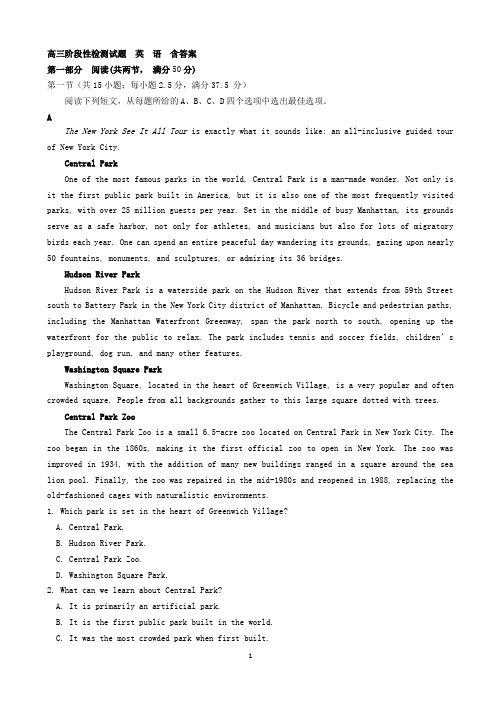
高三阶段性检测试题英语含答案第一部分阅读(共两节,满分50分)第一节(共15小题;每小题2.5分,满分37.5 分)阅读下列短文,从每题所给的A、B、C、D四个选项中选出最佳选项。
AThe New York See It All Tour is exactly what it sounds like: an all-inclusive guided tour of New York City.Central ParkOne of the most famous parks in the world, Central Park is a man-made wonder. Not only is it the first public park built in America, but it is also one of the most frequently visited parks, with over 25 million guests per year. Set in the middle of busy Manhattan, its grounds serve as a safe harbor, not only for athletes, and musicians but also for lots of migratory birds each year. One can spend an entire peaceful day wandering its grounds, gazing upon nearly 50 fountains, monuments, and sculptures, or admiring its 36 bridges.Hudson River ParkHudson River Park is a waterside park on the Hudson River that extends from 59th Street south to Battery Park in the New York City district of Manhattan. Bicycle and pedestrian paths, including the Manhattan Waterfront Greenway, span the park north to south, opening up the waterfront for the public to relax. The park includes tennis and soccer fields, children’s playground, dog run, and many other features.Washington Square ParkWashington Square, located in the heart of Greenwich Village, is a very popular and often crowded square. People from all backgrounds gather to this large square dotted with trees.Central Park ZooThe Central Park Zoo is a small 6.5-acre zoo located on Central Park in New York City. The zoo began in the 1860s, making it the first official zoo to open in New York. The zoo was improved in 1934, with the addition of many new buildings ranged in a square around the sea lion pool. Finally, the zoo was repaired in the mid-1980s and reopened in 1988, replacing the old-fashioned cages with naturalistic environments.1. Which park is set in the heart of Greenwich Village?A. Central Park.B. Hudson River Park.C. Central Park Zoo.D. Washington Square Park.2. What can we learn about Central Park?A. It is primarily an artificial park.B. It is the first public park built in the world.C. It was the most crowded park when first built.D. It especially attracts pedestrians and artists.3. When was the first official zoo in New York repaired for the first time?A. In the 1860s.B. In 1934.C. In the mid-1980s.D. In 1988.BThere is a song by the great Jamaican singer Bob Marley called So Much Trouble in The World. Marley understood that part of the reason why there are so many problems in the world is the lack of tolerance between people. The UN understands this too — that is why it made November 16th “International Day for Tolerance”.But first, what is tolerance? According to French philosopher Voltaire, “Tolerance is the consequence of humanity. We are all formed of frailty (脆弱) and error; let us pardon each other’s fool —that is the first law of nature.”Very often, people do not realize that they are intolerant. This is because intolerance has a lot to do with ignorance. For example, the UN’s campaign is in part about the treatmen t of females by males. But often, the behavior of men toward women is intolerant because men do not put themselves in the shoes of women.It is worth thinking a little about the words “tolerance” and “intolerance”. Are they the best words to describe the e vils of which we are speaking here? To agree to be “tolerant” of someone is not necessarily a very respectful thing. When someone is tolerated, it implies that there is something wrong with them.Still, what Voltaire said stands: We humans are not perfect and this weakness is something that we all share. That is the reason we should be tolerant. It is a little like generosity. We can give things to another person, and we can also give our forgiveness4. What is the purpose of the UN “International Day for Tolerance”?A. To celebrate the founding of the UN.B. To solve the problem of global warming.C. To change people’s opinion towards globalization.D. To arouse the awareness of tolerance among people.5. Why do men behave intolerantly towards women?A. Because men do not realize the purpose of the UN.B. Because men are physically stronger than women.C. Because men are not willing to understand womenD. Because men do not appreciate the shoes of women.6. Why is it meaningless to use the words “tolerance” and “intolerance”?A. Because they cannot be used in a respectful way.B. Because they are hard to pronounce in English.C. Because they cannot be translated into other languages.D. Because they do not express the exact meaning people refer to.。
河南省2020届高三上学期阶段性考试(三)英语(扫描版)
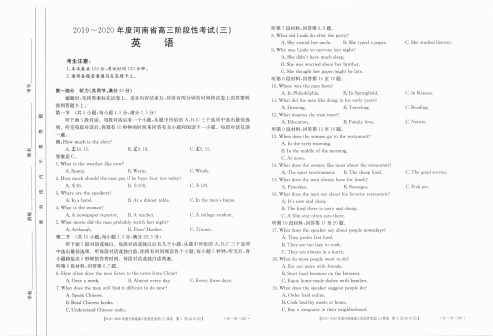
!"#$!"!"年度河南省高三阶段性考试三34;%&!'(
G/4M-49$;:31.6M-3/B/;-D/4-3<53$623<-E688.-/D3<-E/4262B01B/3<-4-528/48-4;6B;4-5MD593528 35M-/2-/D3<-642-G9=5=-49528V:934-.5QD/452</:4/49/0K<-64=52A5M-954-8-.6A6/:90K<->8/2C3<5I5Ka623<-4-$G<6A<1./I-E/930K<->V:93<5I-9/E-V5OOE:96A$I-4>H:6-3$2/3<62B3//./:80?<53C9 >/:4D5I/463-4-935:4523% +#?-..$63C9V:935I-4>96E=.-4-935:45230K<-4-54-/2.>5;/:396Q35;.-9623<-4-0WA/:=.-/DG5634-99-9G-54 :B.>=62M:26D/4E90L:33<-D//869B4-53$I-4>3593>$528A<-5=3//$G<6A<696E=/43523$/DA/:49-0K<-454-9/E-34:AM846I-49963362B533<-A/:23-48462M62BA/DD--528-5362B95:95B-9-I-4>E/4262B015.G5>9<5I=52A5M-9623<-E/4262B5283<-64D69<=6-D/4.:2A<0K<534-935:4523<59;--2/=-2D/4E52>>-5490K<->95> 3<-5A3/4]5E-9Z-52-5393<-4-9/E-36E-9$;:318/2C33<62M3<53C934:-0 停顿 "")"!* 重复 停顿 "")!"* 哔P 听下面一段独白$回答第#_至第!"四个小题!现在$你有!"秒钟的时间阅读这四个小题! 停顿 "")!"* 哔P (!"#$#")
普通高中2020届高三上学期英语质量监测试卷一)(小段音频)

普通高中2020届高三上学期英语质量监测试卷(一)(小段音频)一、听下面5段对话。
每段对话后有一个小题,从题中所给的A、B、C三个选项中选出最佳选项。
(共5小题;每小题1.5分,满分7.5分)1. Where does the conversation take place?A . In a library.B . In a bank.C . In a bookshop.2. How does the man feel about the final exam?A . Relaxed.B . Confident.C . Worried.3. How much do the tickets cost?A . £9.B . £10.C . £11.4. What does the woman suggest?A . Henry needs some pills.B . Henry should do some exercise.C . Henry should see a doctor.5. What is the man sorry for?A . Having an argument.B . Not being calm.C . His being late.二、听下面5段对话或独白。
每段对话或独白后有几个小题,从题中所给的A、B、C三个选项中选出最佳选项。
(共15小题;每小题1.5分,满分22.5分)6. 听下面一段较长对话,回答以下小题。
1.(1) How will the woman get to the party?A . By taking a bus.B . By driving her car.C . By getting a ride.2.(2) What will the man do at noon?A . Meet the woman.B . Have his car repaired.C . Talk with Ms. Wilson.7. 听下面一段较长对话,回答以下小题。
2020届高三英语上学期阶段性检测试题
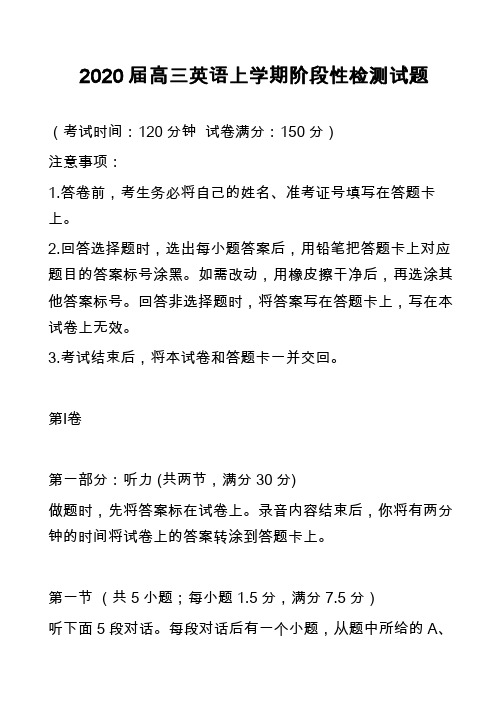
2020届高三英语上学期阶段性检测试题(考试时间:120分钟试卷满分:150分)注意事项:1.答卷前,考生务必将自己的姓名、准考证号填写在答题卡上。
2.回答选择题时,选出每小题答案后,用铅笔把答题卡上对应题目的答案标号涂黑。
如需改动,用橡皮擦干净后,再选涂其他答案标号。
回答非选择题时,将答案写在答题卡上,写在本试卷上无效。
3.考试结束后,将本试卷和答题卡一并交回。
第Ⅰ卷第一部分:听力 (共两节,满分30分)做题时,先将答案标在试卷上。
录音内容结束后,你将有两分钟的时间将试卷上的答案转涂到答题卡上。
第一节(共5小题;每小题1.5分,满分7.5分)听下面5段对话。
每段对话后有一个小题,从题中所给的A、B、C三个选项中选出最佳选项。
听完每段对话后,你都有10秒钟的时间来回答有关小题和阅读下一小题。
每段对话仅读一遍。
1. What’s John doing now?A. Playing football.B. Watching TV.C. Studying.2. What can the man do?A. Swim.B. Play soccer.C. Play basketball.3. When will the meeting be over?A. At 11:00.B. At 10:00.C. At 9:30.4. What does the woman think of the play?A. Terrible.B. Just so-so.C. Great.5. What’s the weather like now?A. Snowy.B. Rainy.C. Sunny.第二节(共15小题,每小题1.5分,满分22.5分)听下面5段对话或独白。
每段对话或独白后有几个小题,从题中所给的A、B、C三个选项中选出最佳选项。
听每段对话或独白前,你将有时间阅读各个小题,每小题5秒钟;听完后,各小题将给出5秒钟的作答时间。
2019-2020年高三上学期第一次阶段性测试英语试题含答案
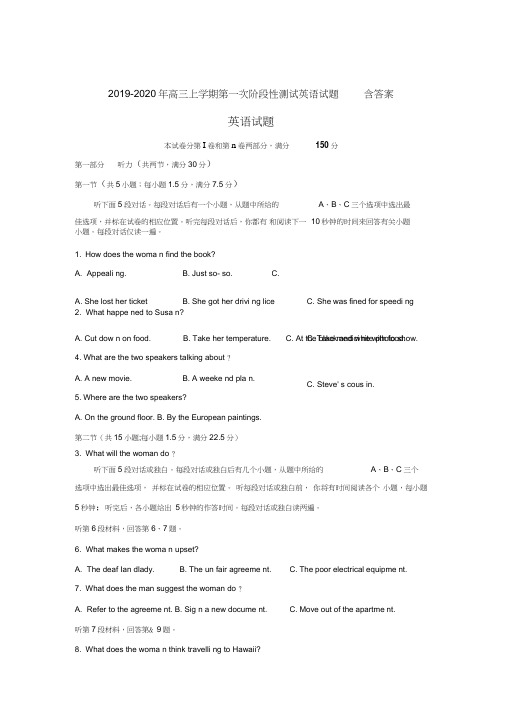
2019-2020年高三上学期第一次阶段性测试英语试题 含答案英语试题本试卷分第I 卷和第n 卷两部分,满分150分第一部分 听力(共两节,满分30分) 第一节(共5小题;每小题1.5分,满分7.5分)听下面5段对话。
每段对话后有一个小题,从题中所给的 佳选项,并标在试卷的相应位置。
听完每段对话后,你都有 和阅读下一小题。
每段对话仅读一遍。
1. How does the woma n find the book?A. Appeali ng.B. Just so- so. 2. What happe ned to Susa n?3. What will the woman do ?听下面5段对话或独白。
毎段对话或独白后有几个小题,从题中所给的 A 、B 、C 三个选项中选出最佳选项, 并标在试卷的相应位置。
听每段对话或独白前, 你将有时间阅读各个 小题,每小题5秒钟;听完后,各小题给出 5秒钟的作答时间。
每段对话或独白读两遍。
听第6段材料,回答第6、7题。
6. What makes the woma n upset?A. The deaf Ian dlady.B. The un fair agreeme nt. 7. What does the man suggest the woman do ?A. Refer to the agreeme nt.B. Sig n a new docume nt.听第7段材料,回答第& 9题。
8. What does the woma n think travelli ng to Hawaii?A 、B 、C 三个选项中选出最10秒钟的时间来回答有关小题C.StrangA. She lost her ticketB. She got her drivi ng license C. She was fined for speedi ng A. Cut dow n on food. B. Take her temperature. 4. What are the two speakers talking about ?A. A new movie.B. A weeke nd pla n. 5. Where are the two speakers?A. On the ground floor.B. By the European paintings.第二节(共15小题;每小题1.5分,满分22.5分)C. Take medici ne with food.C. Steve' s cous in.C. At the black and white photo show. C. The poor electrical equipme nt.C. Move out of the apartme nt.11. What 'the relati on ship betwee n the two speakers?12. What are the two speakers mai nly talki ng about?B. Importa nee of exercise.C. Adva ntages of tak ing the subway. 听第9段材料,回答第13至16题。
2020届高三上学期阶段性考试英语试题
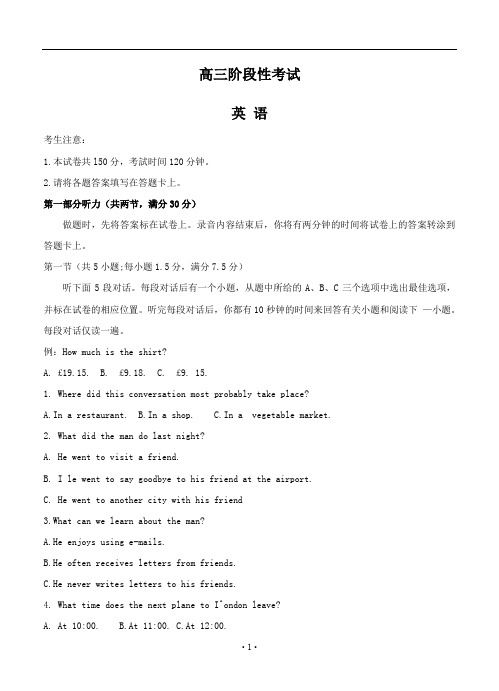
高三阶段性考试英语考生注意:1.本试卷共l50分,考試时间120分钟。
2.请将各题答案填写在答题卡上。
第一部分听力(共两节,满分30分)做题时,先将答案标在试卷上。
录音内容结束后,你将有两分钟的时间将试卷上的答案转涂到答题卡上。
第一节(共5小题;每小题1.5分,满分7.5分)听下面5段对话。
每段对话后有一个小題,从题中所给的A、B、C三个选项中选出最佳选项,并标在试卷的相应位置。
听完每段对话后,你都有10秒钟的时间来回答有关小题和阅读下—小题。
每段对话仅读一遍。
例:How much is the shirt?A. £19.15.B. £9.18.C. £9. 15.1. Where did this conversation most probably take place?A.In a restaurant.B.In a shop.C.In a vegetable market.2. What did the man do last night?A. He went to visit a friend.B. I le went to say goodbye to his friend at the airport.C. He went to another city with his friend3.What can we learn about the man?A.He enjoys using e-mails.B.He often receives letters from friends.C.He never writes letters to his friends.4. What time does the next plane to I^ondon leave?A. At 10:00.B.At 11:00.C.At 12:00.5. What is the man's problem?A.He isn't filing well.B. He is caught in bad weather.C. He feels very cold第二节(共15小题,每小题1.5分,满分22.5分)听下面5段对话或独白。
- 1、下载文档前请自行甄别文档内容的完整性,平台不提供额外的编辑、内容补充、找答案等附加服务。
- 2、"仅部分预览"的文档,不可在线预览部分如存在完整性等问题,可反馈申请退款(可完整预览的文档不适用该条件!)。
- 3、如文档侵犯您的权益,请联系客服反馈,我们会尽快为您处理(人工客服工作时间:9:00-18:30)。
高三年级阶段测试卷英语(考试时间:120分钟试卷满分:150分)注意事项:1.答卷前,考生务必将自己的姓名、准考证号填写在答题卡上。
2.回答选择题时,选出每小题答案后,用铅笔把答题卡上对应题目的答案标号涂黑。
如需改动,用橡皮擦干净后,再选涂其他答案标号。
回答非选择题时,将答案写在答题卡上,写在本试卷上无效。
3.考试结束后,将本试卷和答题卡一并交回。
第Ⅰ卷第一部分:听力(共两节,满分30分)做题时,先将答案标在试卷上。
录音内容结束后,你将有两分钟的时间将试卷上的答案转涂到答题卡上。
第一节(共5小题;每小题1.5分,满分7.5分)听下面5段对话。
每段对话后有一个小题,从题中所给的A、B、C三个选项中选出最佳选项。
听完每段对话后,你都有10秒钟的时间来回答有关小题和阅读下一小题。
每段对话仅读一遍。
1. What’s John doing now?A. Playing football.B. Watching TV.C. Studying.2. What can the man do?A. Swim.B. Play soccer.C. Play basketball.3. When will the meeting be over?A. At 11:00.B. At 10:00.C. At 9:30.4. What does the woman think of the play?A. Terrible.B. Just so-so.C. Great.5. What’s the weather like now?A. Snowy.B. Rainy.C. Sunny.第二节(共15小题,每小题1.5分,满分22.5分)听下面5段对话或独白。
每段对话或独白后有几个小题,从题中所给的A、B、C三个选项中选出最佳选项。
听每段对话或独白前,你将有时间阅读各个小题,每小题5秒钟;听完后,各小题将给出5秒钟的作答时间。
每段对话或独白读两遍。
听下面一段对话,回答第6和第7两个小题。
6. Where does the man want to go?A. The library.B. The lab.C. The café.7. What’s the man’s major?A. Psychology.B. Physics.C. Chemistry.听下面一段对话,回答第8至第10三个小题。
8. Where is the woman going first?A. The classroom.B. The library.C. The gym.9. What will the woman do in the library?A. Borrow some books.B. Return some books.C. Study for the exam.10. Why do the speakers go to the gym?A. To watch a game.B. To take a PE class.C. To go swimming.听下面一段对话,回答第11至第13三个小题。
11. What do we know about the man?A. He is in poor health.B. He wants to stay at home today.C. He hasn’t finishe d his homework yet.12. What relation is Mr. Bell to the man?A. His neighbor.B. His teacher.C. His father.13. What does the man ask the woman to do?A. Help him hand in his project.B. Call to ask for leave.C. Drive him to school right now.听下面一段对话,回答第14至第16三个小题。
14. What will the man do in the late afternoon?A. Give a speech.B. Write a magazine article.C. Prepare some materials.15. Where will the man have dinner tonight?A. At home.B. In the office.C. In a meeting room.16. How will the man go back home?A. By bus.B. By car.C. By taxi.听下面一段独白,回答第17至第20四个小题。
17. What can we learn about Pedal Power?A. It was started in 1996.B. It gives bicycles to people for free.C. It sends bicycles to poor areas regularly.18. What happened to Pedal Power in August 2000?A. It couldn’t meet its costs.B. It won an Enterprise Award.C. It was criticized by the British media.19. When did Dan Pearman go to Ecuador?A. In 1993.B. In 1998.C. In 2001.20. Why was Dan Pearman’s neighbor successful in business?A. He offered many jobs to craftsmen in the town.B. He was the most skilled craftsman in the village.C. He could reach customers easily by riding his bike.第二部分:阅读理解(共两节,满分35分)第一节(共10小题;每小题2.5分,满分25分)阅读下列短文,从每题所给的四个选项(A、B、C和D)中,选出最佳选项,并在答题卡上将该项涂黑。
AYou may be surprised to learn that English gets 30 to 45 percent of its words from French.The reason goes back to the year 1066, when Norman forces invaded (入侵) what is now Britain. The Normans were from northern France and spoke French. During the Norman occupation, French became the language of England’s rulers and wealthy class. This lasted for more than 300 years. Other people in England continued to speak English during this period.Over time, the two languages combined and shared words. Some researchers believe that about 10,000 French words eventually entered the English language. However, although English took many French words, their meanings have not always stayed the same. Sometimes the differences in meanings can be very important, and lead to funny or strange situations if the words are used in the wrong way.Take, for example, the French word college. In English, college can often be used in place of the word university, or sometimes as a school within a university. However, in French, college actually means “middle school”, or the level of schooling for students in grades five or six through eight.There are many other similar words in the two languages with completely different meanings. In English, the word chat is a verb which means “to talk casually”; but in French, the word chat is the word for an animal: a cat.If an English speaker says someone is jolly, that means they are cheerful or friendly. But in French, jolie means someone is good-looking or pleasant to look at. In any case, both are nice things to say to someone.21. What language did the upper class speak in Britain of Norman times ?A. English.B. French.C. Both English and French.D. Some unknown language.22. What does college mean in French?A. The teenager time.B. University in French.C. Middle school in English.D. University in common sense.23. What is the text mainly about?A. Comparison between two languages.B. Difficulty in grasping English.C. French words in English.D. Development of English.BThe world’s two largest pizza chains, Dominos and Pizza Hut, are constantly trying to come up with new ways to keep existing customers and attract new ones. While Dominos attract fans by using high-tech concepts like delivery robots, Pizza Hut focuses on making the delivery box more exciting. In 2015, they introduced a pizza box that could be transformed into a movie projector (放映机) and now, one that turns into a fully functioning DJ.The battery-powered DJ Pizza box looks like a normal delivery box from outside. However, flip (轻弹) it up and you will find something amazing. To transform the box into a playable DJ, the user has to sync it to a smart phone or computer via Bluetooth and connect it to a DJ software. Once the setup is complete, the DJ can instantly become the life of the party by pressing on the cardboard keys in the box.As you may have already guessed, getting your hands on this lightweight DJ turntable is not going to be easy. The limited edition box which was shown to the public earlier this month is only available in the United Kingdom, and even worse, at just five of the country’s 350 Pizza Hut location.Though that is unfortunate, Pizza Hut did introduce a Flick Football Field pizza box for its US fans this week. It features a football field printed on top and comes with removable goal posts, football triangles, and a scorecard. The tabletop game is played by flipping the paper balls back and forth across the board and seeing where they land on the scoreboard. The player with the highest score wins. Though it may not be as exciting as the playable DJ, the game board is easier to obtain since they are available at all US Pizza Hut locations with the purchase of a medium pie.24. Why does Pizza Hut focus on new forms of delivery boxes?A. To absorb Dominos.B. To increase its sales.C. To make its pizza tastier.D. To please British customers.25. What does the underlined word “sync” in Paragraph 2 probably mean?A. Add.B. Link.C. Gather.D. Collect.26. What do we know about the Flick Football Field box?A. It is a limited edition pizza box.B. It is intended for customers in the US.C. Any Pizza Hut customer can get one.D. It seems more interesting than a DJ box.CEmoji might not be your first choice of communication in a disaster, but researchers feel they could make a difference during emergencies, where every second counts. Now, the Emoji-quake campaign is lobbying for an earthquake emoji to be accepted into the Unicode—the standard group of icons (图标) available on digital devices worldwide. The campaign aims to find an earthquake-appropriate design to be admitted to Unicode.“Approximately up to one third of the world’s population are exposed to earthquakes,” explains University of Southampton seismologist (地震学家) Dr. Stephen Hicks, a founder of the campaign. “So we really want to be able to communicate to all of those regions, all of those different languages, and an emoji is an amazing way of doing that.”Unlike many other weather and climate related events, where longer warning times or visible signs are available, earthquakes move incredibly quickly and are difficult to measure while they are still occurring. Populations in areas like Japan and Mexico are dependent on earthquake early warning technology, which issues an alert on digital devices and broadcast media. “You may have seconds to get under a table or to protect yourself,” explains Dr. Hicks. “That can be life saving in many cases. Naturally you don’t want too much wording in thewarning message.”Pictographs (象形文字) and other visuals like emoji have a track record of being faster and easier to understand than written information. Dr. Sara McBride, a communications specialist, who is also part of t he campaign, told BBC News, “Emoji can cross the boundaries of written languages, helping communicate valuable information to people who may struggle to read a certain language.”The potential usefulness of emoji in emergencies could extend well beyond earthquakes.A team of designers also came up with emerji—an entire set of emoji for climate and environmental events.27. What was the aim of the Emoji-quake campaign?A. To add an earthquake emoji to the Unicode.B. To attract people’s attention to eart hquakes.C. To reduce the damages by earthquakes.D. To help communicate in earthquakes.28. What can we infer from Dr. Sara McBride’s words about emoji?A. Visuals like emoji can convey more information.B. Emoji is being used to convey valuable information.C. Emoji can cross the boundaries of written languages.D. Emoji is a universal language in human communication.29. What may be the relationship between emoji and emerji?A. Emerji is part of emoji.B. Emoji is included into emerji.C. They are two independent systems.D. Emerji is for events beyond earthquakes.30. Which of the following may be the best title of the passage?A. Could an emoji save our life?B. What can emoji do in our life?C. How is emoji changing our life?D. Do we really know about emoji?第二节(共5小题;每小题2分,满分10 分)根据短文内容,从短文后的选项中选出能填入空白处的最佳选项。
